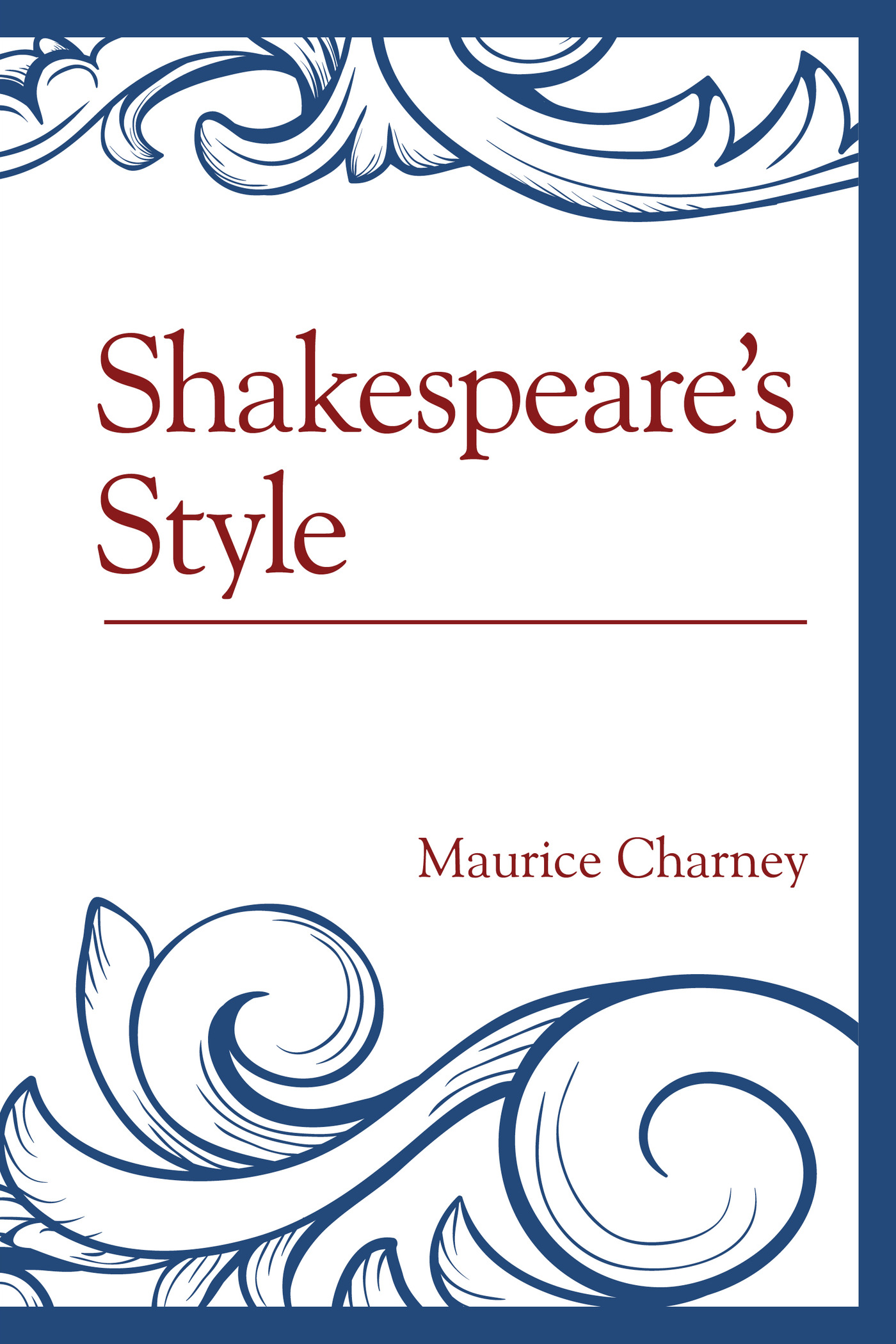Shakespeares Style
Shakespeares Style
Maurice Charney

FAIRLEIGH DICKINSON UNIVERSITY PRESS
Madison Teaneck
Published by Fairleigh Dickinson University Press
Copublished by The Rowman & Littlefield Publishing Group, Inc.
4501 Forbes Boulevard, Suite 200, Lanham, Maryland 20706
www.rowman.com
16 Carlisle Street, London W1D 3BT, United Kingdom
Copyright 2014 by Maurice Charney
All rights reserved. No part of this book may be reproduced in any form or by any electronic or mechanical means, including information storage and retrieval systems, without written permission from the publisher, except by a reviewer who may quote passages in a review.
British Library Cataloguing in Publication Information Available
Library of Congress Cataloging-in-Publication Data
Charney, Maurice.
Shakespeare's style / Maurice Charney.
pages cm
Includes bibliographical references and index.
ISBN 978-1-61147-764-1 (cloth : alk. paper) -- ISBN 978-1-61147-765-8 (electronic)
1. Shakespeare, William, 1564-1616--Literary style. I. Title.
PR3072.C44 2014
822.3'3--dc23
2014025021
 TM The paper used in this publication meets the minimum requirements of American National Standard for Information Sciences Permanence of Paper for Printed Library Materials, ANSI/NISO Z39.48-1992.
TM The paper used in this publication meets the minimum requirements of American National Standard for Information Sciences Permanence of Paper for Printed Library Materials, ANSI/NISO Z39.48-1992.
Printed in the United States of America
For
Bobbie
Muse of Divagations
Acknowledgments
Shakespeares plays are quoted from The Complete Signet Classic Shakespeare, ed. Sylvan Barnet (New York: Harcourt Brace Jovanovich, 1972), with the exception of King Lear, which is quoted from the Arden edition, 3rd series, ed. R. A. Foakes (London: Thomson Learning, 1997). I follow the chronological order of the plays as listed in the Signet edition. I have profited greatly from the notes in the Signet and Arden editions, from my wide reading in the critical literature about Shakespeare, and from stimulating conversations with my students, academic colleagues, and the members of the Shakespeare Seminar at Columbia University.
Introduction
Shakespeares Style offers a close reading of all of Shakespeares plays, with each short chapter devoted to a single aspect of Shakespeares art. I use the word style in a wide sense that includes how characters are fashioned, what key words and images are used to express a plays distinctive meanings, as well as the important nonverbal, presentational aspect of the plays as seen or imagined in performance. Although not strictly a scholarly book (it has no footnotes or bibliography), Shakespeares Style is nevertheless aimed at committed readers and spectators of Shakespeares plays and the growing number of Shakespeares plays that may be seen in movies or on television. The book grows out of the same effort to understand the complexity of the vast critical inquiry about Shakespeares art as the scholarly books I have written.
These include Shakespeares Roman Plays: The Function of Imagery in the Drama (1961), dealing with verbal and nonverbal aspects of Julius Caesar, Antony and Cleopatra, and Coriolanus; Style in Hamlet (1969); Hamlets Fictions (1988, reissued 2014); Titus Andronicus (1990); Shakespeare on Love and Lust (2000); Wrinkled Deep in Time: Aging in Shakespeare (2009); and Shakespeares Villains (2012). But with serious students of Shakespeare also in mind, I have written a different kind of book in How to Read Shakespeare (1971, revised 1992) and All of Shakespeare (1993). The latter deals comprehensively with all of Shakespeares works. Shakespeares Style is a kind of sequel to All of Shakespeare, except that it is directed to Shakespeares plays alone, and it concerns itself with only a single aspect of style in each play.
I do not use the idea of Shakespeares style in its narrower, rhetorical sense, referring only to effects of language. The Roman writer Quintilian of the first century CE established elaborate rhetorical categories for Latin that were taken over by English theorists such as George Puttenham in his Art of English Poesy (1589). One frequently used rhetorical device in Shakespeare is zeugma, which the Oxford English Dictionary (OED) defines as A figure by which a single word is made to refer to two or more words in the sentence. Another frequent rhetorical figure in Shakespeare is hendiadys, which the OED defines as A figure of speech in which a single complex idea is expressed by two words connected by a conjunction. A variety of hendiadys is in the compacted phrase sleepy bed, meaning bed in which I am asleep. One can pursue this subject in detail in the excellent study by Sister Miriam Joseph, Shakespeares Use of the Arts of Language (1947).
I am also interested in how characters are conceived and fashioned. I do not mean to practice old-fashioned character analysis, but it is significant how characters are created stylistically. Old-fashioned Shakespeare criticism usually refers to romantic and often sentimental writers on Shakespeare of the nineteenth century. I am thinking, particularly, of Sir Sidney Lees biography, A Life of William Shakespeare (1898), in which Prospero in The Tempest is seen as an autobiographical portrait of Shakespeare himself bidding farewell to the stage and retiring as a dramatist. This cannot be factually true, and Lees thinking violates the fictionality of Shakespeares characters. There is no consistent line of development in these characters. His representations of women, for example, vary widely from the vivacious and intelligent females of the comedies, like Rosalind in As You Like It and Beatrice in Much Ado About Nothing, to the relatively passive and long-suffering women of the tragedies, like Ophelia in Hamlet and Desdemona in Othello.
Shakespeares plays are not directly autobiographical. One of the most curious examples of the way that Shakespeares mythical sorrows enter into Shakespeare criticism is in H. Somervilles Madness in Shakespearian Tragedy (1929), which claims that Shakespeare himself was suffering from the brain damage brought about by syphilis when he created the character of Timon in Timon of Athens.
We need to insist on the fictionality of Shakespeares characters. This is where stylistic considerations play an important part. Hamlet is one of the most well-rounded and fully developed characters in all of Shakespeare, but there are seeming contradictions in his presentation on stage. If he is a character who thinks too much (and that is the root of his tragedy, as in the movie with Laurence Olivier), he is also quite homicidal in his pursuit of revenge. In act 3, scene 3, he doesnt consider it a good revenge to kill the king while he is praying, and, in the next scene, he runs Polonius through without ascertaining whether or not his victim is indeed the king. If Hamlets tragedy is really caused by the fact that he thinks too much, how does one explain his soliloquy at the end of act 3, scene 2, where he says: Now could I drink hot blood / And do such bitter business as the day / Would quake to look on (3.2.398400). He is steeling himself not to murder his mother. Shakespeare seems to be arranging various aspects of Hamlets character for their maximum theatrical effect.
Next page





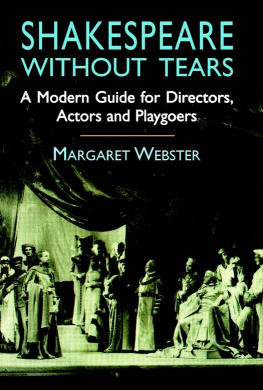


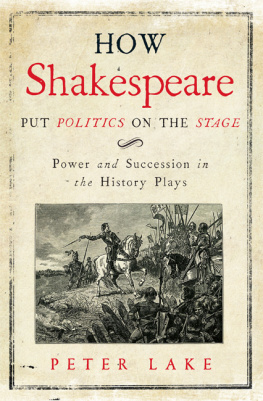
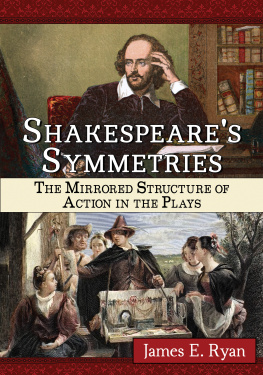



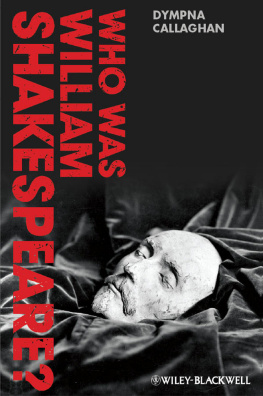

 TM The paper used in this publication meets the minimum requirements of American National Standard for Information Sciences Permanence of Paper for Printed Library Materials, ANSI/NISO Z39.48-1992.
TM The paper used in this publication meets the minimum requirements of American National Standard for Information Sciences Permanence of Paper for Printed Library Materials, ANSI/NISO Z39.48-1992.